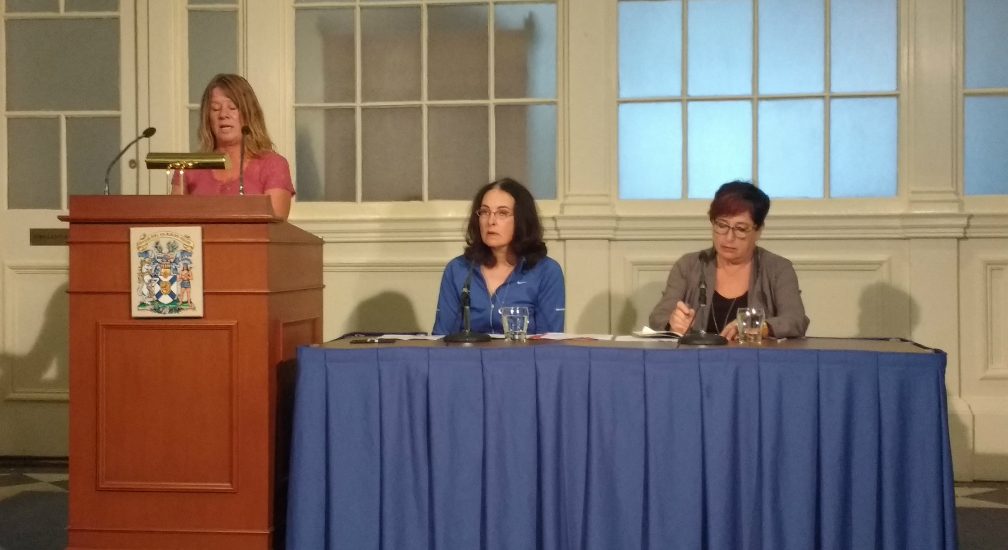KJIPUKTUK (Halifax) – Almost a year after Equity Watch’s interventions, the Nova Scotia Human Rights Commission convened a Board of Inquiry (a tribunal) to hear Kathy Symington’s complaint of discrimination on the basis of sex and of disability.
In some ways Symington’s case is similar to the ground-breaking case of Liane Tessier, also a former Halifax firefighter. In December 2017, Tessier won her sex discrimination case after a 12 year battle. Ken Steubing, Chief of Halifax Regional Fire and Emergency, had to publicly apologize to Tessier for “systemic gender discrimination” in the fire service.

Since the chief admitted to systemic gender discrimination, you’d think that Symington’s complaints, which began shortly after she joined the fire service in 1997, would be accepted and a settlement offered. But no, Symington has had to fight for more than 14 years for her complaint to get before a human rights Board of Inquiry. She first filed a complaint in 2004, but in 2006 the NS Human Rights Commission dismissed it. A decade later, in 2016, Symington again filed a complaint.
Enter Equity Watch, a Halifax-based organization which supports people who are harassed, bullied and face discrimination at work. Last April, Equity Watch mounted a demonstration on Spring Garden Road in front of the Nova Scotia Human Rights Commission’s headquarters. Our placards read: “Human Rights Commission: do your job.”
See also: Protesters want a more effective NS Human Rights Commission
The Commission should have pursued Symington’s first complaint, back in 2004, which they dropped. In 2018, they rejected her second complaint (filed in 2016). There are hundreds of other human rights complainants in Nova Scotia whose complaints have also been summarily dismissed by the Commission.
Equity Watch helped Symington appeal the dismissal of her second complaint. In the summer of 2018, the Human Rights Commission finally agreed to take her case to a Board of Inquiry.
At the hearing, which has taken place over the last 10 days, I was taken aback by the evidence given by one witness whose use of jargon was almost humorous – if the circumstances had not been so serious. The witness works in the Human Resources department of Halifax Regional Municipality (HRM). Her job was to find Symington another job either in the fire service or anywhere in HRM, as she could no longer do her the job of a firefighter.
I confess to having taught Human Resource Management at the Sobey School of Business at Saint Mary’s University for 18 years. But I have never heard anyone use corporate jargon as the witness did when she talked about personnel issues. The witness’ testimony was nothing short of “newspeak”.
First, the woman witness from Human Resources called herself a “senior consultant in HR.” She said her title was changed to “Business Partner to Fire and Emergency Services.”
The “Business Partner” explained that the goal for the accommodation process [to place Symington in another role] was based on a “functional match” for the worker, rather than considering her emotional and mental concerns. I think this means the employer would only accommodate for physical problems of the job, not mental or emotional stressors which Symington had. Bear in mind, Symington’s case hinges on two grounds: physical and mental disability as well as sex discrimination.
The Business Partner witness referred to the “vacancy management process” – in plain language that means finding an unfilled job vacancy for Symington. However, prior to filling a vacancy, there had to be a decision about “whether it could be bundled.” What does that mean? I think it means finding out if one job could be added on to another to save a staff position.
The witness said that the CAO (HRM’s Chief Administrative Officer) had decreed that there was to be no budget increase. That meant the Business Partner had to take “a look at every job and prove you need the role – that there are no other modifications needed to fill or bundle the role.” What?
At one stage the Business Partner talked about the “concentration of vacancy savings through vacancy management.” Newspeak if I ever heard it.
The witness, or Business Partner, noted that Symington was “skeptical” about the entire process, though the Business Partner claimed she “listened” to [Symington] and even “empathized” – twice! — with Symington’s concerns. Still the Business Partner blamed Symington for being “un-cooperative” in the process.
Despite the fact that Symington had worked for HRM for 18 years, the Business Partner testified that no job could be found for Symington because she had not submitted a new resume! HRM, and Human Resources and even the Business Partner — knew all about Symington’s condition.
Back in 2005, Symington’s car had been vandalized three times in one year while it was parked outside the fire station where she worked. No one admitted to being the vandal, and there was no investigation by Halifax Fire or anyone else.
Terrified by these incidents, Symington was accommodated in a new role: she went to work temporarily in the Stores area of the Fire Service – far from her home fire station. So it was perfectly clear that she could do the job in Stores.
However, despite Symington having done the job in Stores, the Business Partner claimed there was the problem of the “Job Site Analysis” or JSA. The higher-ups in HRM management seemed to have gone into a tizzy because they thought they would have to modify the Stores job for Symington, “based on her functional capacity, the new location, new duties and new structure.” Really— is that a big deal?
At the hearing I also found out that despite there being a job open in Stores, it took nearly three years to clear it with the top management and the union and then to offer it to Symington.
Before that job, the Business Partner considered placing Symington as a bus driver. However Symington’s “functional capacity” showed “that she wasn’t a “functional match.”
Symington herself gave evidence at the hearing. She said she was told by the union as well as by key people in management that “there was no job for [me] in Fire,”
The Business Partner’s evidence seemed like much ado about nothing. The truth is that
- it took HRM more than two years to find a job that would accommodate Symington.
- Management never told her, or even suggested there was any other job she could do
- Meanwhile Symington had no income, and was desperate for money.
- By May 15, 2015, HRM had solidified the job in Stores for Symington. HRM met with the union, but the union forgot to tell Symington.
- Shortly after that, Symington applied for long-term disability – which meant she was no longer available for a work.
The Business Partner’s testimony was almost laughable. What is clear is that Symington had been left high and dry. After a career in firefighting, she had no job and no future. Symington had dared to complain about sexual harassment and bullying, and she was out of a job.
And she still is.
Judy Haiven is on the steering committee of Equity Watch, an organization that fights discrimination, bullying and racism in the workplace. Contact her at equitywatchns@gmail.com
With a special thanks to our generous donors who make publication of the Nova Scotia Advocate possible.
Subscribe to the Nova Scotia Advocate weekly digest and never miss an article again. It’s free!



